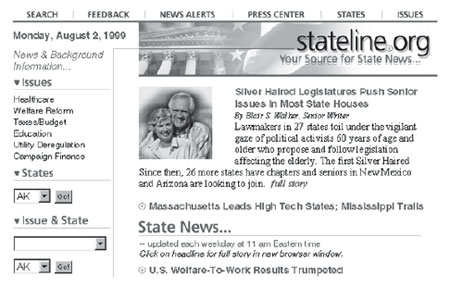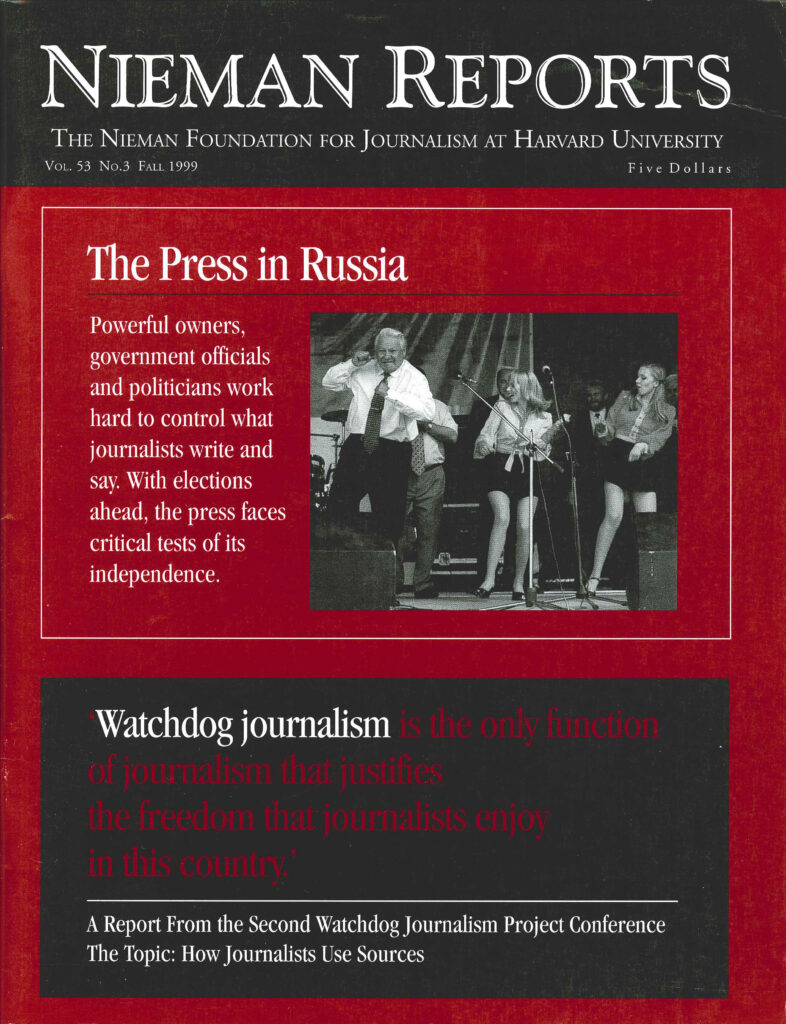When I read that account in USA Today, I thought that if these two computer giants can’t figure out a way to get their act together, no wonder we’ve had so much trouble with our Web design firm. I had a mental picture of programmers from Compaq trying to make sense of the computer code written by their new colleagues at Digital—and failing. That’s because this is what it’s been like for stateline.org, the new Web venture I’ve been putting together with my colleagues for the past nine months. Once again, it seems, the promise held by computers and the people who program and, in this case, build them, outruns their ability to deliver what we might think they can.
And therein lies my tale of Web journalism. If computers are leading the country into some vague, post-industrial future and Web architecture, a fancy term for software, is the industry of the 1990’s as well as Wall Street’s current darling, there’s something wrong with this picture. In fact, it turns out there is something terribly wrong when the point of the enterprise is to create a place where serious journalism can be practiced. It’s as though we come from different tribes; we the journalists, them the programmers. Our language, our customs and habits all arrive with us from different planets.
A bit of background is in order: Since last January 25 stateline.org, a creature of the Pew Center on the States, has been published every day. It’s essentially an information service for state house reporters and anyone else who wants it. Our target audience includes policymakers and engaged citizens, defined as that small band of citizens who take a serious interest in public policy debates. Those debates increasingly take place in state legislatures, thanks to devolution fever that has swept Congress since the Republican takeover in 1994. About 1600 readers visit us daily. We attract them with thorough, careful reporting on major problems facing state legislatures: education, taxes, welfare reform, utility deregulation and health care. We read 140 newspapers each day on line. We excerpt their coverage of state government, link to their Web sites, add our own reporting and publish it all at 11 a.m. each day.
We are deadline addicts: All eight of us journalists are refugees from news papers or network television. Our Managing Editor, Gene Gibbons, is a veteran wire service reporter who spent the last 12 years as chief White House correspondent for Reuters. What sets us apart from the thousands of other sites on the Web is not only our experience in journalism but also our vision of what people are looking for on the Web. We think it’s our ability to give readers the tools they need to tailor the information we provide to meet their deadlines or their information needs.
- Interested in education in Indiana? With two mouse clicks we’ll bring you up to date on every significant story on schools and education policy in the Hoosier state.
- Want to compare the tax burden in Wisconsin to that in Maryland? We can do that as fast as your Pentium chip will allow.
- Want to be notified every time there is something significant to report about the great social experiment with welfare reform?
We are the one stop state policy shop. You can drill deep into our information well or take what you want off the surface. But all of that fast break information rendering is, it turns out, not so easy for a computer to put together.
Our site is not your average newspaper-on-the-Internet. That, I have learned, is what programmers, another name for the techies who write the code that make computers do what they do, call a static site. You put it up and the computer literate come and read it. Not much interaction, no tailoring the information to individuals’ special needs. Not so different from what journalists have always done. The only difference is that on the Web the news doesn’t get wet on rainy days.
What we designed (with the help of three of last year’s Nieman Fellows) is, in techno-speak, a database-driven site. Our consultant, who helped with the site design, almost fell off his chair laughing when I told him what I wanted to create and added, “It ought to be easy.”
Now I know why he laughed.
Call it rule number one: Nothing is easy and certainly nothing is cheap when it comes to the creation of online journalism at this point in the development of the Web and at this level of complexity. Our troubles fell into two categories. The first is attitude and the second is software. By attitude I mean the youthful brio that occasionally morphs into arrogance which characterizes so much of the Internet. I’m old enough to have been around when television news was new and most of us who were attracted to it were young and liked to try new techniques because they had never been tried before, or because no one knew what viewers would watch, or because we knew we would get a rise out of our elders just by doing it.
The Web is like that. No one knows where it’s going, or how it will look when it grows up. It’s only five years old. Maybe it will turn out to be just another giant shopping mall, or maybe it will be a medium that really deserves all its hype. Maybe it truly will help to connect people and serve democracy as well as commerce. But for now it’s a giant, sprawling, infuriatingly disorganized, untidy place where millionaires are created overnight; where consolidation is ongoing and firms are bought and sold in a flash, and where 22 year olds who can write code are earning $55,000 a year.
You can be sure of one thing: This is not a place where journalism and the ethics that govern it find a natural home. There’s a Wild West atmosphere to all of this, and impatience with anything that’s not digital. Anything part of the past is perceived as having little merit. And to the casual observer, the visual power of various news sites can obscure the fact that the information they provide can be wildly inaccurate and unscrupulously biased. It’s a world governed, if it’s governed at all, by Nike’s slogan, “Just do it.”
Like the Web itself, our programmers are young and energetic. You have to be to write the lines of code that make things go. But I have a mental picture of intense men and women working into the night, fueled by a steady diet of takeout pizza and Diet Cokes like the first programmers I ever met at M.I.T.’s Media Lab a decade ago. The difference is now they charge $125 an hour.
Our Web design firm disdained the kind of normal business practices most of us learned a long time ago because they help lubricate the normal friction in any business relationship. Getting this firm to negotiate a contract, for example, was a major undertaking. So was convincing a technocrat that an invoice for more than $70,000 containing just five words to describe the work being billed for that handsome sum fell short of acceptable business practice.
And then there is Cold Fusion. I thought Cold Fusion was something followers of the Reverend Sun Myung Moon tried to sell to unwary travelers at airports in the 1980’s. Turns out it’s a name for software used to manage big, complex, database-driven Web sites. It should have been easy to make it become the engine that drives our site. But it isn’t, and the techies don’t know why.
“We’re meeting with the vendor and we’re sure we can work it out,” they said.
That assurance was months ago. Must be a long meeting.
Still, our Web site works or most of it does most of the time. Our readers don’t complain. Most love us for what we’re publishing. They don’t know the ideas we have in our heads that we can’t execute. They don’t know all the features we had hoped to add and haven’t been able to. It’s as though we had designed a 747, but the plane we take off in every day is more like a 707. It gets you where you want to go, but not in quite the style or comfort we imagined our visitors would be traveling in or thought we paid for.
The lesson I’ve drawn from all the agony of the last nine months? Journalism in cyberspace may have solved distribution problems: The report arrives every day no matter the weather, and it’s never necessary to retrieve it from the bushes where the boy heaved it. But imposing standards is a full-time job. Techies, like the Web itself, are value neutral. They promise more than they deliver and don’t always grasp why some things we ask for are important in upholding the tenets of good journalism. Everything costs more than they said it would.
Nothing is as easy as you think it ought to be.
And without vigilance, the news standards on which all of this ought to be built can start to slip away. 
A later stage in designing the site. Images courtesy of stateline.org
Edward M. Fouhy is Executive Director of the Pew Center on the States and Editor of stateline.org, the daily news policy Web site published by the Center. He held top executive positions at CBS, ABC and NBC.



